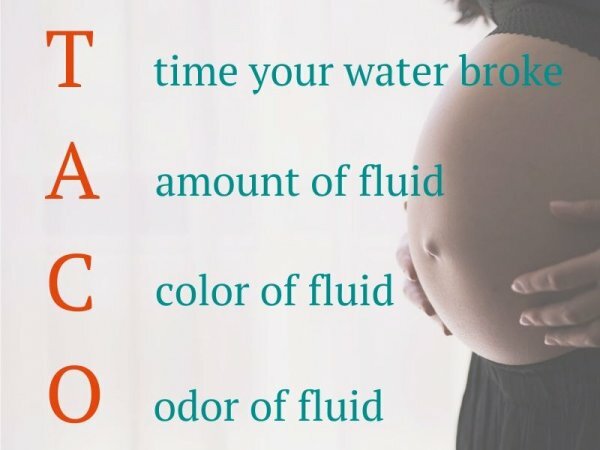When Your Water Breaks

Thinking you won’t be prepared and this will happen at the worst possible time? Don't worry, its less common that you think. Having your water break as the first sign of labor actually only happens 10% or less of the time.
Typically, your water breaks later in labor when the pressure being created by your contractions ruptures the membranes surrounding the bag of waters. However, sometimes it breaks before you even know your in labor and thats okay too. Do not panic if your water breaks, its natural and is just an indicator that you will soon get to see that baby that you have been patiently waiting on.
As you prepare to call your doctor, remember TACO (time, amount, color, odor) to answer the questions they will ask.
Time:
Your care provider will want to know the time your water broke. Typically, a woman delivers her baby within 24 hours of the membranes rupturing. Some care providers prefer that the woman immediately goes to the birth place after her water breaks; this practice is most common when births take place in hospital settings. Other care providers, such as midwives who practice at free-standing birthing centers, may recommend that you do not come to your birth place until you begin having contractions. There is no “right” or “wrong” here–it is a matter of your personal preference and your care provider’s professional preference. Know, however, that the sooner you go to the hospital, the greater the likelihood is that you’ll experience more medical interventions (For example, IVs, internal fetal monitoring, or medications to speed up labor).
Amount:
No, you dont have to have an exact amount or carry a measuring cup to let them know how much water it was. The doctor or midwife just needs a guess; was it a trickle that stopped fairly soon? Does it continue to trickle? Was it a gush?
Color:
“What color is the amniotic fluid?” will be a question you will hear asked. Healthy amniotic fluid should be somewhat clear (it won’t necessarily be perfectly clear like drinking water) to maybe even a milky color. If the color of the fluid is yellowish, brownish, or greenish, it could be signs of meconium. You will want to call your care provider and follow her instructions.
Odor:
Amniotic fluid doesnt have much of a smell, It is not an offensive odor. If the amniotic fluid has any other kind of odor, call your healthcare provider and follow her instructions. It may mean that you have an infection.
Conclusion:
Once you talk to your medical team, they will advise you of what they think is best and you will make the final steps towards meeting your newest addition!
If you are in the Cincinnati or Dayton, Ohio area – look no further. Tamara Kankowski is a certified birth and postpartum doula as well as a childbirth educator. Tamara provides support to families everyday across the region. Tamara has an affordable birth doula package that includes personalized support during your pregnancy, labor and delivery that continues through your first eight weeks postpartum.

